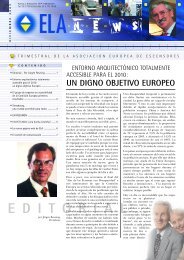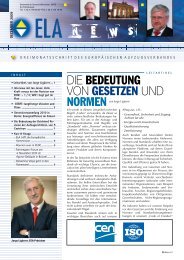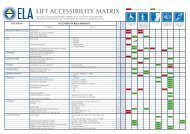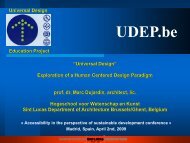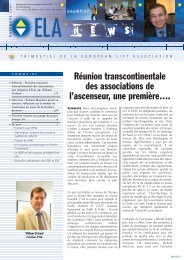WP6-Brochure-E4 brochure - ELA European Lift Association.
WP6-Brochure-E4 brochure - ELA European Lift Association.
WP6-Brochure-E4 brochure - ELA European Lift Association.
Create successful ePaper yourself
Turn your PDF publications into a flip-book with our unique Google optimized e-Paper software.
Further topics<br />
This section addresses further topics that are of relevance if the energy efficiency of lifts is to<br />
be optimised.<br />
Regeneration<br />
Elevators do not only consume energy, they may also generate electricity when they are going<br />
up or down, depending on the loading condition. This is advantageous for several reasons: a)<br />
this electricity may be used by other devices, b) the energy created when the elevator is going<br />
down can be turned into electricity and fed to the grid, meaning less effort is needed for<br />
cooling – thus even less energy is consumed.<br />
From a technical point of view, today it is neither complicated nor expensive to include<br />
regeneration in the lift system. It is a useful feature to increase energy efficiency for many<br />
installations. However, precise knowledge about regeneration is scarce, even among<br />
manufacturers of lifts. Price ranges discussed in this context vary greatly and insecurity is high<br />
regarding legislation on this topic. This is related to the question of whether it is legal to feed<br />
electricity into the grid which is not consumed by other electrical devices immediately. This<br />
topic needs clarification.<br />
Interface building‐installation to be optimised<br />
Further potentials to save energy in the context of lifts can be found at the interface between<br />
lift and building. First of all, lift shafts usually contain shaft vents which are necessary for<br />
ventilation and in case of fire. However, they also act as connections to the outside, i.e. letting<br />
in hot air in the summer and cold air in the winter. Intelligent solutions to prevent this are<br />
available on the market, but are not installed very frequently.<br />
In general, the interface building‐lift is often not analysed from the point of view of energy<br />
efficiency, as lifts are not part of the EPBD and similar regulations. Thus, information<br />
campaigns about the energy efficiency of lifts should not solely concentrate on the lift system<br />
itself, but also on its integration in the building.<br />
Quality of installation<br />
<strong>Lift</strong>s are individually engineered installations. Therefore, similar models may consume different<br />
amounts of energy, due to the specific conditions in the building where they are installed.<br />
However, the quality of work during installation also greatly contributes to energy efficiency –<br />
and is crucial for realising potentials for increasing energy efficiency. Dispan [1] notes that<br />
installation quality has been decreasing due to outsourcing, time and cost pressure. However,<br />
if lifts do not run smoothly due to bad installation quality, a vast amount of energy is wasted.<br />
Accessibility and alternatives to lifts<br />
The <strong>European</strong> population is ageing, awareness of accessibility issues is rising and people are<br />
constantly expecting more comfort in their everyday environment. Thus the demand for<br />
103





